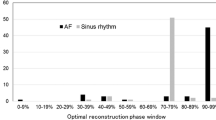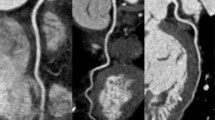Abstract
Purpose
To describe prospective ECG-triggered dual-source CT dual-step pulsing (pECGdual_step) for evaluation of coronary arteries and cardiac function.
Methods
Fifty-one consecutive patients pre- or post-cardiovascular surgery were examined with adaptive sequential tube current modulated (pECGdual-step) 128-slice dual-source CT without heart rate control (main padding window: 40% RR interval >65 bpm/70% RR interval <65 bpm). Image quality of coronary arteries was graded (4-point scale), and cardiac function was evaluated.
Results
Mean HR was 68 bpm. Thirty-seven patients were in stable sinus rhythm (SR); 14 had arrhythmia. Image quality of coronary arteries was diagnostic in 804/816 (98%) of segments. The number of non-diagnostic segments was higher in patients with arrhythmia as compared to those in SR (4% vs. 0.5%; p = 0.01), and there were fewer segments with excellent image quality (79% vs. 94%; p < 0.001) and more segments with impaired image quality (p < 0.001 and p = 0.002). Global and regional LV function could be evaluated in 41 (80%) and 47 (92%) patients, and valvular function in 48 (94%). In 11/14 of patients with arrhythmia, the second step switched to full mAs, increasing radiation exposure to 8.6 mAs (p < 0.001). The average radiation dose was 3.8 mSv (range, 1.7–7.9) in patients in SR.
Conclusion
pECGdual-step128-slice DSCT is feasible for the evaluation of coronary arteries and cardiac function without heart rate control in patients in stable sinus rhythm at a low radiation dose.



Similar content being viewed by others
References
Maruyama T, Takada M, Hasuike T, Yoshikawa A, Namimatsu E, Yoshizumi T (2008) Radiation dose reduction and coronary assessability of prospective electrocardiogram-gated computed tomography coronary angiography: comparison with retrospective electrocardiogram-gated helical scan. J Am Coll Cardiol 52:1450–1455
Arnoldi E, Johnson TR, Rist C, Wintersperger BJ, Sommer WH, Becker A, Becker CR, Reiser MF, Nikolaou K (2009) Adequate image quality with reduced radiation dose in prospectively triggered coronary CTA compared with retrospective techniques. Eur Radiol 19:2147–2155
Earls JP, Berman EL, Urban BA, Curry CA, Lane JL, Jennings RS, McCulloch CC, Hsieh J, Londt JH (2008) Prospectively gated transverse coronary CT angiography versus retrospectively gated helical technique: improved image quality and reduced radiation dose. Radiology 246:742–753
Hirai N, Horiguchi J, Fujioka C, Kiguchi M, Yamamoto H, Matsuura N, Kitagawa T, Teragawa H, Kohno N, Ito K (2008) Prospective versus retrospective ECG-gated 64-detector coronary CT angiography: assessment of image quality, stenosis, and radiation dose. Radiology 248:424–430
Shuman WP, Branch KR, May JM, Mitsumori LM, Lockhart DW, Dubinsky TJ, Warren BH, Caldwell JH (2008) Prospective versus retrospective ECG gating for 64-detector CT of the coronary arteries: comparison of image quality and patient radiation dose. Radiology 248:431–437
Scheffel H, Alkadhi H, Leschka S, Plass A, Desbiolles L, Guber I, Krauss T, Gruenenfelder J, Genoni M, Luescher TF, Marincek B, Stolzmann P (2008) Low-dose CT coronary angiography in the step-and-shoot mode: diagnostic performance. Heart 94:1132–1137
Stolzmann P, Leschka S, Scheffel H, Krauss T, Desbiolles L, Plass A, Genoni M, Flohr TG, Wildermuth S, Marincek B, Alkadhi H (2008) Dual-source CT in step-and-shoot mode: noninvasive coronary angiography with low radiation dose. Radiology 249:71–80
Dewey M, Müller M, Eddicks S, Schnapauff D, Teige F, Rutsch W, Borges AC, Hamm B (2006) Evaluation of global and regional left ventricular function with 16-slice computed tomography, biplane cineventriculography, and two-dimensional transthoracic echocardiography: comparison with magnetic resonance imaging. J Am Coll Cardiol 48:2034–2044
Sarwar A, Shapiro MD, Nasir K, Nieman K, Nomura CH, Brady TJ, Cury RC (2009) Evaluating global and regional left ventricular function in patients with reperfused acute myocardial infarction by 64-slice multidetector CT: a comparison to magnetic resonance imaging. J Cardiovasc Comput Tomogr 3:170–177
Cury RC, Nieman K, Shapiro MD, Butler J, Nomura CH, Ferencik M, Hoffmann U, Abbara S, Jassal DS, Yasuda T, Gold HK, Jang IK, Brady TJ (2008) Comprehensive assessment of myocardial perfusion defects, regional wall motion, and left ventricular function by using 64-section multidetector CT. Radiology 248:466–475
Kristensen TS, Kofoed KF, Møller DV, Ersbøll M, Kühl T, von der Recke P, Køber L, Nielsen MB, Kelbæk H (2009) Quantitative assessment of left ventricular systolic wall thickening using multidetector computed tomography. Eur J Radiol 72:92–97
Ko SM, Kim YJ, Park JH, Choi NM (2009) Assessment of left ventricular ejection fraction and regional wall motion with 64-slice multidetector CT: a comparison with two-dimensional transthoracic echocardiography. Br J Radiol. doi:10.1259/bjr/38829806
Lüders F, Fischbach R, Seifarth H, Wessling J, Heindel W, Juergens KU (2009) Dual-source computed tomography: effect on regional and global left ventricular function assessment compared to magnetic resonance imaging. Rofo 181:962–969
Feuchtner GM, Dichtl W, Friedrich GJ, Frick M, Alber H, Schachner T, Bonatti J, Mallouhi A, Frede T, Pachinger O, zur Nedden D, Müller S (2006) Multislice computed tomography for detection of patients with aortic valve stenosis and quantification of severity. J Am Coll Cardiol 47:1410–1417
Alkadhi H, Desbiolles L, Stolzmann P, Leschka S, Scheffel H, Plass A, Schertler T, Trindade PT, Genoni M, Cattin P, Marincek B, Frauenfelder T (2009) Mitral annular shape, size, and motion in normals and in patients with cardiomyopathy: evaluation with computed tomography. Invest Radiol 44:218–225
Leipsic J, Wood D, Manders D, Nietlispach F, Masson JB, Mayo J, Al-Bugami S, Webb JG (2009) The evolving role of MDCT in transcatheter aortic valve replacement: a radiologists' perspective. AJR Am J Roentgenol 193:W214–W219
Tsai IC, Lin YK, Chang Y, Fu YC, Wang CC, Hsieh SR, Wei HJ, Tsai HW, Jan SL, Wang KY, Chen MC, Chen CC (2009) Correctness of multi-detector-row computed tomography for diagnosing mechanical prosthetic heart valve disorders using operative findings as a gold standard. Eur Radiol 19:857–867
Ertel D, Lell MM, Harig F, Flohr T, Schmidt B, Kalender WA (2009) Cardiac spiral dual-source CT with high pitch: a feasibility study. Eur Radiol 19:2357–2362
Achenbach S, Marwan M, Schepis T, Pflederer T, Bruder H, Allmendinger T, Petersilka M, Anders K, Lell M, Kuettner A, Ropers D, Daniel WG, Flohr T (2009) High-pitch spiral acquisition: a new scan mode for coronary CT angiography. J Cardiovasc Comput Tomogr 3:117–121
Leschka S, Stolzmann P, Desbiolles L, Baumueller S, Goetti R, Schertler T, Scheffel H, Plass A, Falk V, Feuchtner G, Marincek B, Alkadhi H (2009) Diagnostic accuracy of high-pitch dual-source CT for the assessment of coronary stenoses: first experience. Eur Radiol 19:2896–2903
Lell M, Marwan M, Schepis T, Pflederer T, Anders K, Flohr T, Allmendinger T, Kalender W, Ertel D, Thierfelder C, Kuettner A, Ropers D, Daniel WG, Achenbach S (2009) Prospectively ECG-triggered high-pitch spiral acquisition for coronary CT angiography using dual-source CT: technique and initial experience. Eur Radiol. doi:10.1007/s00330-009-1558-4
Seifarth H, Wienbeck S, Püsken M, Juergens KU, Maintz D, Vahlhaus C, Heindel W, Fischbach R (2007) Systole better phase: Optimal systolic and diastolic reconstruction windows for coronary CT angiography using dual-source CT. AJR Am J Roentgenol 189:1317–1323
Alkadhi H, Stolzmann P, Scheffel H, Desbiolles L, Baumüller S, Plass A, Genoni M, Marincek B, Leschka S (2008) Radiation dose of cardiac dual-source CT: the effect of tailoring the protocol to patient-specific parameters. Eur J Radiol 68:385–391
Feuchtner GM, Jodocy D, Klauser A, Haberfellner B, Aglan I, Spoeck A, Hiehs S, Soegner P, Jaschke W (2009) Radiation dose reduction by using 100-kV tube voltage in cardiac 64-slice computed tomography: A comparative study. Eur J Radiol. doi:10.1016/j.ejrad.2009.07.012
Menzel H, Schibilla H, Teunen D (2000) European guidelines on quality criteria for computed tomography, Publication no. EUR 16262 EN. Luxembourg: European Commission
Jakobs TF, Becker CR, Ohnesorge B, Flohr T, Suess C, Schoepf UJ, Reiser MF (2002) Multislice helical CT of the heart with retrospective ECG gating: reduction of radiation exposure by ECG-controlled tube current modulation. Eur Radiol 12:1081–1086
Hausleiter J, Meyer T, Hermann F, Hadamitzky M, Krebs M, Gerber TC, McCollough C, Martinoff S, Kastrati A, Schömig A, Achenbach S (2009) Estimated radiation dose associated with cardiac CT angiography. JAMA 301:500–507
Hermann F, Martinoff S, Meyert T et al (2008) Reduction of radiation dose estimates in cardiac 64-slice CT angiography in patients after coronary artery bypass graft surgery. Invest Radiol 43:253–260
Leschka S, Stolzmann P, Schmid FT, Scheffel H, Stinn B, Marincek B, Alkadhi H, Wildermuth S (2008) Low kilovoltage cardiac dual-source CT: attenuation, noise, and radiation dose. Eur Radiol 18:1809–1817
Anders K, Baum U, Gauss S, Kuefner MA, Achenbach S, Kuettner A, Daniel WG, Uder M, Ropers D (2009) Initial experience with prospectively triggered, sequential CT coronary angiography on a 128-slice scanner. Rofo 181:332–338
Author information
Authors and Affiliations
Corresponding author
Electronic supplementary materials
Valvular function: 4D cine loops (corresponding movie to Fig. 1) show opening and closure of combined stenosed and regurgitant aortic valve during entire cardiac cycle. (AVI 3,239 kb)
Mechanical prosthetic valve: 4D cine loops during entire cardiac cycle, normal function (corresponding movie to Fig. 3) (AVI 1,949 kb)
Rights and permissions
About this article
Cite this article
Feuchtner, G., Götti, R., Plass, A. et al. Dual-step prospective ECG-triggered 128-slice dual-source CT for evaluation of coronary arteries and cardiac function without heart rate control: a technical note. Eur Radiol 20, 2092–2099 (2010). https://doi.org/10.1007/s00330-010-1794-7
Received:
Revised:
Accepted:
Published:
Issue Date:
DOI: https://doi.org/10.1007/s00330-010-1794-7




